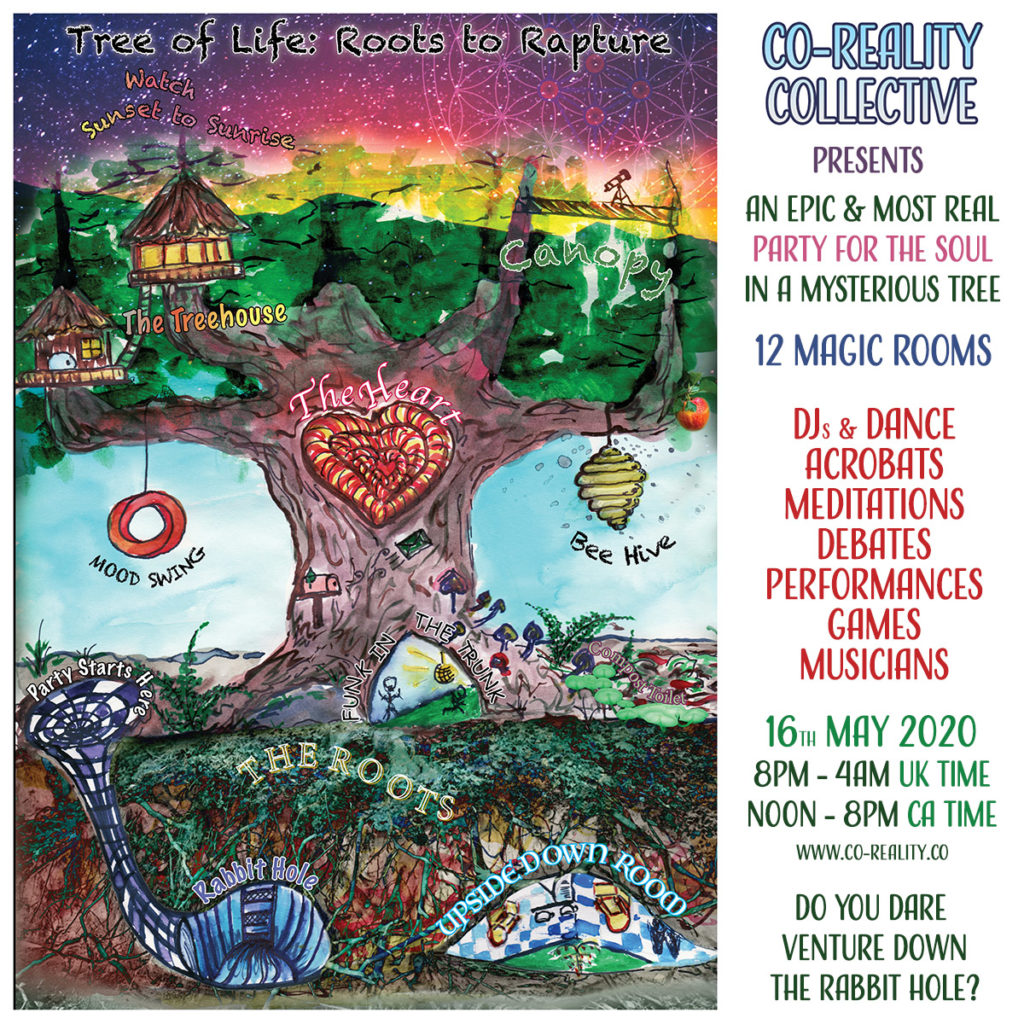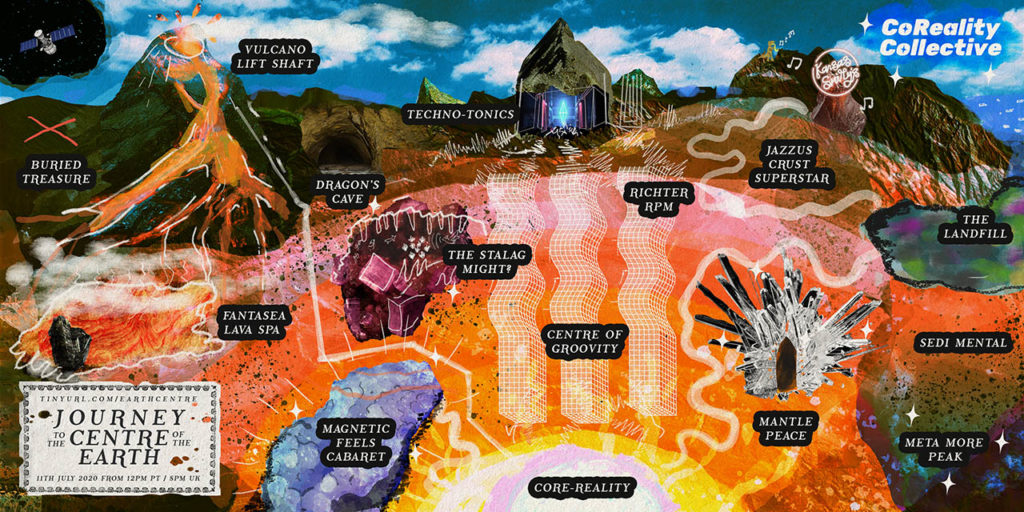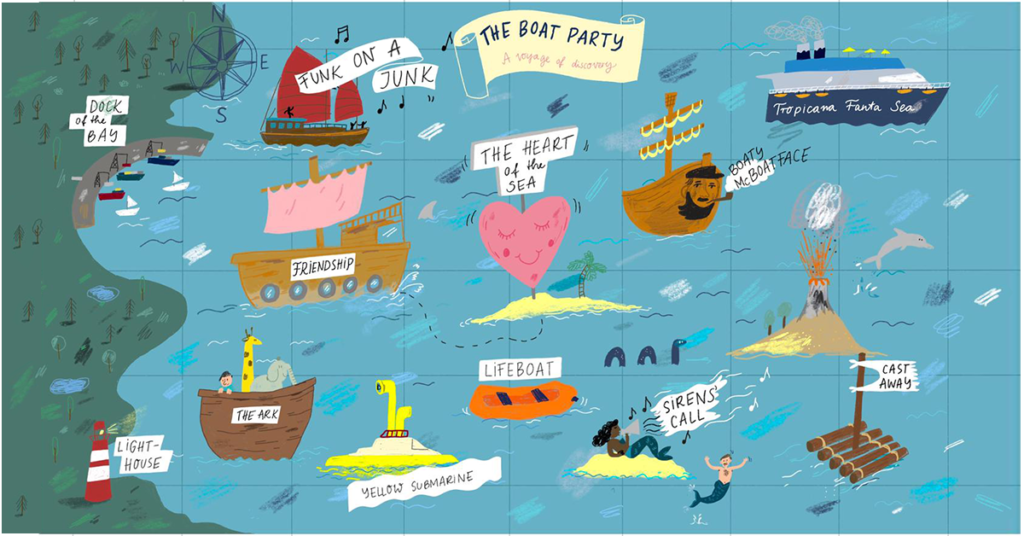No screenshots on the dancefloor: The Co-Reality Collective

Frank Sonder, international keynote speaker on the transformation of society and the economy through tech, dives inside the self-proclaimed “realest party on the internet” by the Co-Reality Collective, to see what kind of experience the format can provide, and if it has a future. Here is his recount…
Given the unpleasant prospect that larger club parties will not be able to take place in the long term, one can either switch to outdoor events or think intensively about whether at least part of the party experience can also be created online.
The creators of the Co-Reality Collective probably thought along the same lines when they organised the first edition of their “realest party on the internet” in April. The interesting thing about the online party is that it requires little more than the video conferencing software Zoom, which each of us should have tried out at least once somewhere by now. Once again it shows that it is much less about the technology than about a coherent and consistent concept, and an interesting story with creative implementation.
For research purposes the author therefore threw himself into what is now the fourth edition of the party, which takes place every two weeks, to find out what it’s all about.

Beforehand, I read in an article what the creators had already learned by now: a real party should start with a well-designed invitation and not just a link to the registration form. Because of the global reach, it is essential to consider time zones, unlike at normal parties. By focusing on Europe, it was decided to start at 8pm GMT until sometime in the early morning hours. However this did not stop partygoers from Down Under from partying in the middle of the day. This could be seen in the high sun in the Australian bush.
Everything starts with the purchase of a ticket, which can be handled by Eventbrite for the sake of simplicity. Prices range from a free ticket to around $50 if you can afford it. Basically, the method here is that everyone pays as much as they can. After all, access is not completely free, as is, unfortunately, the case with most virtual formats these days. This regularly deprives the organisers of a reasonable business model and it is generally difficult to monetise an event that was initially completely free of charge later on.

Except for the confirmation of the ticket purchase, there was only a short email afterward, which contained the link to a Zoom meeting room and some final instructions [as below].
Tips for partygoers:
1. Prepare yourself with appropriate costumes and props to enjoy the party. Appropriate costumes include tree-themed costumes, including tree-dwelling animals and anything which looks like fancy dress.
2. Prepare your space: decorate your space, or enable a virtual background.
3. Ready yourself a glass of Prosecco to be welcomed upon your arrival at the Tree of Life
In any case, it is important and helpful to have detailed instructions in which everything is explained step-by-step, starting with the least talented user (in Germany also called DAU – the Dumbest Assumable User).


It starts with a click on the received link followed by some requirements to launch the external program. But even for users who have never done this before, it is an acceptable hurdle. Once this has been done, the fun begins – by standing in line. Because, as is well known, every good club party is accompanied by the anticipation that comes with waiting. In concrete terms, this means that party-goers who are eager to celebrate end up in a video conference room, where they are greeted by two nice doormen and checked for party fitness. Those who are in the right mood, have their self-prepared welcome drink with them, and are dressed up according to the theme of the party, come in. Those who did not manage to prepare a suitable costume for the theme of the party have two digital possibilities. On the one hand, the background image can be adapted to the party motto. It couldn’t be simpler. On the other hand, the Snapcamera from Snapchat allows you to cover your video ego with one of the funny masks.
Some people are brought together with others at will and at random. This is done in so-called breakout rooms, which are used in regular video conferences for group work. The host of the room simply has to transport individual users to these séparées. Here there is then the opportunity and, to a certain extent, the necessity to get to know other partygoers.
Whoever has made it this far will get the magic link to a website where you can finally get an overview of the whole party. There is also an interactive map, designed according to the theme, where you can find links to all the other “floors”. In the end, these are just more video conference rooms that differ from each other thematically or musically. In addition to various dance floors, there are also rooms with storytellers, fortune tellers, and all sorts of other purposes, which are not always entirely clear. Of course, there is also a toilet.

When entering another room, the party-goers are asked to give themselves a Victorian name, for example. Those who couldn’t think of one immediately are helped by a link to a website that generates such names at random.
Another room was called the bathtub and this was meant absolutely literally. Because here only those who sat at home in their own bathtub, appropriately unclothed, had access. With water, of course. Certainly one of the best examples of how real and virtual rooms can be mixed effectively –also known as mixed reality.
There was already a lot to learn. Namely that the party should have a theme that has to be used throughout. That coming into the experience must be designed and explained. That it needs doormen, concierges and hosts. That the party guests must be offered orientation with a map. But that should not be all…
Apropos theme: this is essential. At the Co Reality Collective there were among others The Zone, The Light Side of the Moon, Tree of Life, The Time Warp Party followed by The End of the Universe. Such a theme may of course be mysterious – not necessarily easily understandable, but mysterious and surprising to the end.

Surely the newcomer is sitting in front of his computer a little confused at first. At his desk or with his laptop on his knees on the sofa. But it doesn’t stay that way for long. Given the many small video snippets on the screen, nobody hides for long in the semi-darkness of the room, possibly with the video switched off. (I confess that I activated my video and audio-only after several friendly requests “There is Frank, let us see you”. After all, I was only out and about for research purposes). There are many dancing people to be seen, real or virtually dressed up, and also a woman who is apparently undergoing body painting somewhere in the jungle. And another one, who is obviously experiencing a sunrise from the boot of her mobile home.
After all the foreplay, talking and animation by the hosts, the music really gets going. That means, on each “floor” someone else hangs up. However, anyone who has ever made a zoom call with a large number of participants knows about the limitations of the audio that this technology still has. But the creators have also thought about this and recommend switching the zoom audio to mute and switching to twitch.tv for live music instead. Twitch actually comes from the gamer scene and is meant to watch other players at their pleasure. However, twitch had evolved towards music and partying, even before the pandemic, so it’s no surprise that the audio quality, which is usually lousy for video conferencing, is much better here. There is a link in every chat on every dance floor that simply redirects you to the gamer platform. Everybody can still do that, even if she or he has already had a few more of his or her own welcome drinks.

And so it goes on all night, interrupted only by a midnight ritual, because the organisers believe that it is extremely important to create community by bringing everyone together. For this purpose, all but one room is closed. Here the pack gathers and follows the ritual, which is explained by the hosts. All those who had been personally affected by the coronavirus were asked to hold their open hand in front of the camera or screen. All others followed this with their hands as well, while individual affected people told their story. A thoroughly emotional moment in which the real distance became irrelevant.
Like at any good club party, people get into a conversation at some point, driven by the need to share their innermost feelings with others beyond the loud music. There are separate rooms for this as well where, with a little effort, a conversation can be held, or at the very least the slightly or heavily drunken palaver of other party guests can be followed. To put it clearly, chaos is inherent – and not only that which is caused by the party and its guests themselves. Chaos can and must also be expected in planning and coordination. Experiments can go wrong, concepts fail or are misunderstood. All this is part of it.

Even so, such an event requires serious planning and a lot of supporters. Well-organised communication before and during the event as well as good coordination between all participants, even at 3 o’clock on the morning.
Such concepts have the potential to be economically profitable. Be it through the sale of tickets, whereby free tickets should always be considered, or donations. Especially if the first attempts are positively spread in the community, it may cost a lot.
Last but not least it is recommended to ask feedback of your party guests afterward. The tools for this are numerous and the findings are worth their weight in gold. For the next issue.
Frank Sonder is an international consultant, speaker and facilitator in the future-facing world of technology and design.
